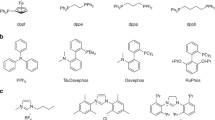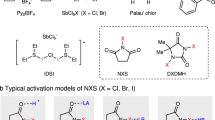Abstract
Anti-Markovnikov hydroazidation of unactivated alkenes using ABX2014;N3 as an initiator has been developed at room temperature, wherein hydrogen azide (HN3) acts as both hydrogen and azidating agent. Notably, the HN3 reagent was generated from azidotrimethylsilane (TMSN3) and acetic acid in situ. The reaction itself displays broad substrate scope, good yields and excellent regioselectivities.
Similar content being viewed by others
References
Roesky PW, Müller TE. Angew Chem Int Ed, 2003, 42: 2708–2710
Espino CG, Fiori KW, Kim M, Du Bois J. J Am Chem Soc, 2004, 126: 15378–15379
Utsunomiya M, Hartwig JF. J Am Chem Soc, 2003, 125: 14286–14287
Brice JL, Harang JE, Timokhin VI, Anastasi NR, Stahl SS. J Am Chem Soc, 2005, 127: 2868–2869
Müller TE, Hultzsch KC, Yus M, Foubelo F, Tada M. Chem Rev, 2008, 108: 3795–3892
Huang L, Arndt M, Gooßen K, Heydt H, Gooßen LJ. Chem Rev, 2015, 115: 2596–2697
Bernoud E, Lepori C, Mellah M, Schulz E, Hannedouche J. Catal Sci Technol, 2015, 5: 2017–2037
Villa M, Jacobi von Wangelin A. Angew Chem Int Ed, 2015, 54: 11906–11908
Pirnot MT, Wang YM, Buchwald SL. Angew Chem Int Ed, 2016, 55: 48–57
Michon C, Abadie MA, Medina F, Agbossou-Niedercorn F. J Organomet Chem, 2017, 847: 13–27
Beller M, Trauthwein H, Eichberger M, Breindl C, Herwig J, Müller TE, Thiel OR. Chem Eur J, 1999, 5: 1306–1319
Takemiya A, Hartwig JF. J Am Chem Soc, 2006, 128: 6042–6043
Nguyen TM, Nicewicz DA. J Am Chem Soc, 2013, 135: 9588–9591
Musacchio AJ, Nguyen LQ, Beard GH, Knowles RR. J Am Chem Soc, 2014, 136: 12217–12220
Takaya J, Hartwig JF. J Am Chem Soc, 2005, 127: 5756–5757
Rucker RP, Whittaker AM, Dang H, Lalic G. J Am Chem Soc, 2012, 134: 6571–6574
Zhu S, Buchwald SL. J Am Chem Soc, 2014, 136: 15913–15916
Nguyen TM, Manohar N, Nicewicz DA. Angew Chem Int Ed, 2014, 53: 6198–6201
Ensign SC, Vanable EP, Kortman GD, Weir LJ, Hull KL. J Am Chem Soc, 2015, 137: 13748–13751
Musacchio AJ, Lainhart BC, Zhang X, Naguib SG, Sherwood TC, Knowles RR. Science, 2017, 355: 727–730
Zhu Q, Graff DE, Knowles RR. J Am Chem Soc, 2018, 140: 741–747
Lardy SW, Schmidt VA. J Am Chem Soc, 2018, 140: 12318–12322
For recent reviews, see: Wu K, Liang Y, Jiao N. Molecules, 2016, 21: 352
For recent selected examples, see: Fu N, Sauer GS, Saha A, Loo A, Lin S. Science, 2017, 357: 575–579
Peng H, Yuan Z, Chen P, Liu G. Chin J Chem, 2017, 35: 876–880
Yang B, Lu Z. ACS Catal, 2017, 7: 8362–8365
Bunescu A, Ha TM, Wang Q, Zhu J. Angew Chem Int Ed, 2017, 56: 10555–10558
Liu Z, Liu ZQ. Org Lett, 2017, 19: 5649–5652
Cong F, Wei Y, Tang P. Chem Commun, 2018, 54: 4473–4476
Shen SJ, Zhu CL, Lu DF, Xu H. ACS Catal, 2018, 8: 4473–4482
Zhang L, Liu S, Zhao Z, Su H, Hao J, Wang Y. Chem Sci, 2018, 9: 6085–6090
Li WY, Wu CS, Wang Z, Luo Y. Chem Commun, 2018, 54: 11013–11016
Zhang YX, Jin RX, Yin H, Li Y, Wang XS. Org Lett, 2018, 20: 7283–7287
Waser J, Carreira EM. Azides by olefin hydroazidation reactions. In: Bräse S, Banert K, Eds. Organic Azides: Syntheses and Applications. Chichester: John Wiley & Sons, 2010. 95–111
Waser J, Nambu H, Carreira EM. J Am Chem Soc, 2005, 127: 8294–8295
Waser J, Gaspar B, Nambu H, Carreira EM. J Am Chem Soc, 2006, 128: 11693–11712
Va P, Campbell EL, Robertson WM, Boger DL. J Am Chem Soc, 2010, 132: 8489–8495
Leggans EK, Barker TJ, Duncan KK, Boger DL. Org Lett, 2012, 14: 1428–1431
Lonca GH, Ong DY, Tran TMH, Tejo C, Chiba S, Gagosz F. Angew Chem Int Ed, 2017, 56: 11440–11444
Kapat A, Konig A, Montermini F, Renaud P. J Am Chem Soc, 2011, 133: 13890–13893
Wang JJ, Yu W. Chem Eur J, 2019, 25: 3510–3514
Wang Y, Li GX, Yang G, He G, Chen G. Chem Sci, 2016, 7: 2679–2683
Wang Y, Hu X, Morales-Rivera CA, Li GX, Huang X, He G, Liu P, Chen G. J Am Chem Soc, 2018, 140: 9678–9684
Jimeno C, Renaud P. Organic Azides. Hoboken: Wiley-Blackwell, 2010. 239–267
For selected examples of azido radical additions to olefins, see: Minisci F, Galli R, Gazz MC. Chim Ital, 1964, 94: 67–90
Trahanovsky WS, Robbins MD. J Am Chem Soc, 1971, 93: 5256–5258
Magnus P, Lacour J, Evans PA, Roe MB, Hulme C. J Am Chem Soc, 1996, 118: 3406–3418
Matcha K, Narayan R, Antonchick AP. Angew Chem Int Ed, 2013, 52: 7985–7989
Wei XH, Li YM, Zhou AX, Yang TT, Yang SD. Org Lett, 2013, 15: 4158–4161
Zhang B, Studer A. Org Lett, 2013, 15: 4548–4551
Li Z, Zhang C, Zhu L, Liu C, Li C. Org Chem Front, 2014, 1: 100–104
Yin H, Wang T, Jiao N. Org Lett, 2014, 16: 2302–2305
Zhu L, Yu H, Xu Z, Jiang X, Lin L, Wang R. Org Lett, 2014, 16: 1562–1565
Su H, Li W, Xuan Z, Yu W. Adv Synth Catal, 2015, 357: 64–70
Sun X, Li X, Song S, Zhu Y, Liang YF, Jiao N. J Am Chem Soc, 2015, 137: 6059–6066
Valiulin RA, Mamidyala S, Finn MG. J Org Chem, 2015, 80: 2740–2755
Zhu R, Buchwald SL. J Am Chem Soc, 2015, 137: 8069–8077
Yuan YA, Lu DF, Chen YR, Xu H. Angew Chem Int Ed, 2016, 55: 534–538
During the investigating substrate scope of the reaction, Xu and co-workers reported a similar reaction. For details, see: Li H, Shen SJ, Zhu CL, Xu H. J Am Chem Soc, 2019, 141: 9415–9421
It should be noted that HN3 generated in situ is a highly toxic and dangerously explosive reagent. Thus, once reaction completed, a strong base NaOH should be added to quench it before the sequential workup procedure.
Acknowledgements
This work was supported by the National Basic Research Program of China (973-2015CB856600), the National Natural Science Foundation of China (21532009, 21821002, 21790330, 21761142010), the Science and Technology Commission of Shanghai Municipality (17XD1404500, 17QA1405200, 17JC1401200), the strategic Priority Research Program (XDB20000000) and the Key Research Program of Frontier Science (QYZDJSSW-SLH055) of the Chinese Academy of Sciences.
Author information
Authors and Affiliations
Corresponding author
Ethics declarations
Conflict of interest The authors declare that they have no conflict of interest.
Electronic supplementary material
Rights and permissions
About this article
Cite this article
Li, X., Chen, P. & Liu, G. Iodine(III) reagent (ABX—N3)-induced intermolecular anti-Markovnikov hydroazidation of unactivated alkenes. Sci. China Chem. 62, 1537–1541 (2019). https://doi.org/10.1007/s11426-019-9628-9
Received:
Accepted:
Published:
Issue Date:
DOI: https://doi.org/10.1007/s11426-019-9628-9




